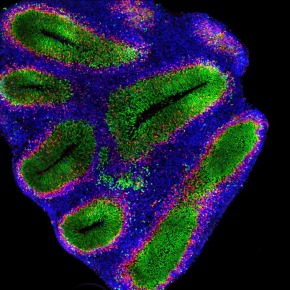
France 2030: the CNRS and Inserm have launched a programme to understand how cells choose their fate and sometimes go awry
A human organism consists of more than 35 billion cells, all of which come from a single initial cell. This cell multiplies, with each of its descendants subsequently choosing a specific fate. How do cells decide their fate during development? Can we intervene to correct their trajectory when a dysfunction leads to pathologies? That is what the new Cell-ID research programme will try to illuminate. Led by the CNRS and Inserm, this programme is funded in the amount of 50 million euros over seven years in connection with France 2030. By combining a multidisciplinary approach and new technologies, it aims to lay the foundations for cell-based “interception” medicine, which can detect and correct cell abnormalities before they become problematic.
|
While all of an individual’s cells contain the same DNA code, they do not all read it the same way. The different ways of interpreting this genetic code therefore contribute to the definition of cell identity. The scientific community–notably via the LifeTime European initiative–has shown that cell fate defects are involved in numerous pathologies, including cancer. Recent advances that make it possible to study each cell individually have paved the way for in-depth exploration of cell identity, as well as the mechanisms through which cell fate determination operates across time and space.
In this context, the Cellular Identities and Destinies (Cell-ID) national research programme proposes understanding when, how, and why a cell follows a particular fate under normal conditions, as well as how it deviates from this during pathologies.
Led by the CNRS and Inserm, and including numerous partners (Institut Curie, Institut Pasteur, CEA, universities, hospitals, and industrial actor1 ), Cell-ID officially began on 22 November 2024, with 50 million euros in funding over seven years under the France 2030 investment plan.
The programme will use imaging methods, functional genomics, and the development of complex tissue models. Special emphasis will be placed on modelling data, which will be shared thanks to a dedicated infrastructure implemented in connection with this programme.
By choosing to concentrate on neural development and paediatric brain cancer, Cell-ID aims to pursue early diagnosis of these pathologies. Researchers hope to improve monitoring during treatment, as well as to prevent the risk of aggravation or relapse. Paediatric cancers have a high cost and societal impact for the children and families concerned; the scientific advances targeted by Cell-ID could allow for acting in advance, with a view to limiting these repercussions and eventually improving the quality of life for these children and their circle.
With the combined forces of the CNRS, Inserm, and programme partners, over 30 research teams in France are taking part in this ambitious project. A multidisciplinary approach is central, with Cell-ID combining biology, physics, computer science, mathematics, chemistry, and medicine. The objective is first and foremost to mobilise the nation’s full scientific expertise to study a given cell from all angles. The programme also includes a training and innovation component for the researchers of the future. Beyond laboratory research, it also includes a communication component intended for the general public and patients, designed to respond to their expectations and to ensure the research conducted is understood by society.
The Cell-ID programme should enable important technological advances that could be applied in various fields such as diseases of an infectious, cardiovascular, chronic inflammatory, and neurodegenerative nature, in addition to other types of cancer. Calls for proposals could eventually be held to strengthen approaches, and to include other pathologies.

Cortical organoid at the 8-week stage. © Alexandre Baffet, Institut Curie
The government has dedicated 3 billion euros to France 2030 for research, in the form of ambitious research programmes led by research institutions, with a view to consolidating French leadership in key fields connected to a technological, economic, societal, health, or environmental transformation, and that are considered a priority on the national or European level. The French National Research Agency (ANR) is the operator for France 2030 research programmes on behalf of the government. |
Regarding the France 2030 investment plan
Expresses a dual ambition: to lastingly transform key sectors of our economy (health, energy, automobiles, aeronautics, and space) through technological innovation, and to position France not just as an actor but as a leader in the world of the future. From basic research to the emergence of an idea and the production of a new product or service, France 2030 supports the entire innovation lifecycle up through industrialisation.
Is unprecedented in scope: 54 M€ will be invested so that our enterprises, universities, and research organisations thoroughly succeed their transitions in these strategic sectors. The objective: enable them to competitively respond to the environmental and attractiveness challenges of the coming world, and to foster the emergence of future leaders in our sectors of excellence. France 2030 is defined by two cross-cutting objectives: 50% of its spending will go toward decarbonising the economy, and 50% to emerging actors driving innovation with no unfavourable environmental impact (in accordance with the Do No Significant Harm principle).
Is collectively implemented: conceived and deployed in concert with economic, academic, local, and European actors to identify its strategic orientations and central actions. Project leaders are invited to make their submissions through open, demanding, and selective procedures in order to receive government support.
Is steered by the General Secretariat for Investment on behalf of the French Prime Minister, and implemented by the French Agency for Ecological Transition (ADEME), the French National Research Agency (ANR), Bpifrance, and the Caisse des Dépôts et Consignations (CDC).
Additional information is available on the government’s website and @SGPI_avenir
- 1 l’Université de Montpellier, l’Université de Strasbourg, l’Université Paris Cité, Paris Sciences Lettres, Sorbonne Université, l’Université Toulouse Paul Sabatier, l’Institut Curie, l’Institut Pasteur, the CEA, l’École des Mines, l’Institut Gustave Roussy, and l’IGBMC Strasbourg.


